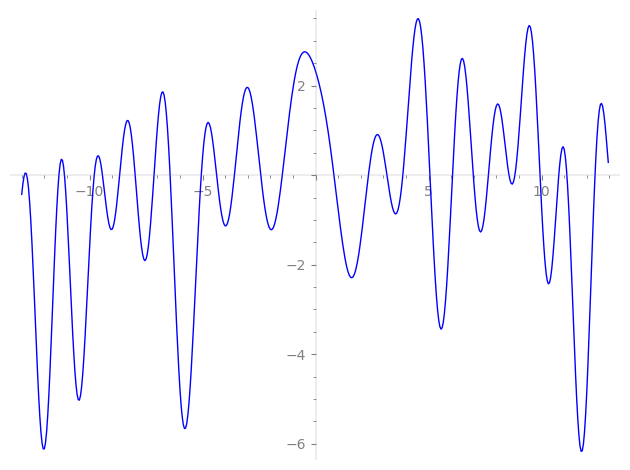| L(s) = 1 | + (1.69 + 0.353i)3-s + (−0.469 − 0.812i)5-s + (2.75 + 1.19i)9-s + (−1.31 + 2.28i)11-s + (2.71 + 4.69i)13-s + (−0.508 − 1.54i)15-s − 3.85·17-s + 1.09·19-s + (3.16 + 5.48i)23-s + (2.05 − 3.56i)25-s + (4.24 + 3.00i)27-s + (−1.94 + 3.36i)29-s + (−2.33 − 4.04i)31-s + (−3.04 + 3.40i)33-s + 2.30·37-s + ⋯ |
| L(s) = 1 | + (0.979 + 0.203i)3-s + (−0.209 − 0.363i)5-s + (0.916 + 0.399i)9-s + (−0.397 + 0.688i)11-s + (0.751 + 1.30i)13-s + (−0.131 − 0.398i)15-s − 0.934·17-s + 0.251·19-s + (0.660 + 1.14i)23-s + (0.411 − 0.713i)25-s + (0.816 + 0.577i)27-s + (−0.360 + 0.624i)29-s + (−0.419 − 0.725i)31-s + (−0.529 + 0.592i)33-s + 0.379·37-s + ⋯ |
Λ(s)=(=(1764s/2ΓC(s)L(s)(0.552−0.833i)Λ(2−s)
Λ(s)=(=(1764s/2ΓC(s+1/2)L(s)(0.552−0.833i)Λ(1−s)
| Degree: |
2 |
| Conductor: |
1764
= 22⋅32⋅72
|
| Sign: |
0.552−0.833i
|
| Analytic conductor: |
14.0856 |
| Root analytic conductor: |
3.75308 |
| Motivic weight: |
1 |
| Rational: |
no |
| Arithmetic: |
yes |
| Character: |
χ1764(1177,⋅)
|
| Primitive: |
yes
|
| Self-dual: |
no
|
| Analytic rank: |
0
|
| Selberg data: |
(2, 1764, ( :1/2), 0.552−0.833i)
|
Particular Values
| L(1) |
≈ |
2.323182724 |
| L(21) |
≈ |
2.323182724 |
| L(23) |
|
not available |
| L(1) |
|
not available |
L(s)=p∏Fp(p−s)−1 | p | Fp(T) |
|---|
| bad | 2 | 1 |
| 3 | 1+(−1.69−0.353i)T |
| 7 | 1 |
| good | 5 | 1+(0.469+0.812i)T+(−2.5+4.33i)T2 |
| 11 | 1+(1.31−2.28i)T+(−5.5−9.52i)T2 |
| 13 | 1+(−2.71−4.69i)T+(−6.5+11.2i)T2 |
| 17 | 1+3.85T+17T2 |
| 19 | 1−1.09T+19T2 |
| 23 | 1+(−3.16−5.48i)T+(−11.5+19.9i)T2 |
| 29 | 1+(1.94−3.36i)T+(−14.5−25.1i)T2 |
| 31 | 1+(2.33+4.04i)T+(−15.5+26.8i)T2 |
| 37 | 1−2.30T+37T2 |
| 41 | 1+(−4.12−7.13i)T+(−20.5+35.5i)T2 |
| 43 | 1+(2.14−3.71i)T+(−21.5−37.2i)T2 |
| 47 | 1+(1.32−2.28i)T+(−23.5−40.7i)T2 |
| 53 | 1+1.27T+53T2 |
| 59 | 1+(3.02+5.23i)T+(−29.5+51.0i)T2 |
| 61 | 1+(−6.71+11.6i)T+(−30.5−52.8i)T2 |
| 67 | 1+(−3.64−6.31i)T+(−33.5+58.0i)T2 |
| 71 | 1−14.7T+71T2 |
| 73 | 1−5.74T+73T2 |
| 79 | 1+(5.51−9.54i)T+(−39.5−68.4i)T2 |
| 83 | 1+(−1.24+2.15i)T+(−41.5−71.8i)T2 |
| 89 | 1+13.5T+89T2 |
| 97 | 1+(1.75−3.03i)T+(−48.5−84.0i)T2 |
| show more | |
| show less | |
L(s)=p∏ j=1∏2(1−αj,pp−s)−1
Imaginary part of the first few zeros on the critical line
−9.427779060536841798490732325669, −8.669649313884591369802831103757, −7.980701999388014397031085282126, −7.14708933107019091876372777572, −6.43536191947359168220630231036, −5.05671385885169713745553396068, −4.37649119714808898729819788378, −3.59100988717328028539353230476, −2.42465255342961919209389013634, −1.47259563181071873567554065750,
0.813487008547812658610409056102, 2.33843160984833997121287921286, 3.15728098356505063822134591280, 3.86061546320768506255029736645, 5.06106711036829587451107764582, 6.05885476538678679749706450730, 6.97823145773251972855698808731, 7.64679560812526509623581273071, 8.558838601422115407081176858887, 8.818785013937507570989210043563

